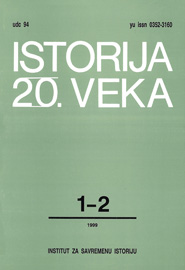NACIONALNO PITANJE I JUGOSLAVIJA 1945-1989.
THE NATIONAL QUESTION AND YUGOSLAVIA 1945-1989
Author(s): Dragan BogetićSubject(s): Political history, Recent History (1900 till today), Nationalism Studies, WW II and following years (1940 - 1949), Post-War period (1950 - 1989), Inter-Ethnic Relations, Identity of Collectives
Published by: Institut za savremenu istoriju, Beograd
Keywords: Yugoslavia; national question; postwar period; national programs; Serbs; Croats;
Summary/Abstract: The solution of the national question in socialist Yugoslavia represented one of the main problems in the preservation of the state, and in ensuring the conditions necessary for the comprehensive economic, political, and cultural progress of its people. It has become evident, however, that the country’s current political leaders do not have the ability to find an acceptable solution to this problem. The continuous crisis troubling Yugoslavia throughout the postwar period was mostly generated by the overwhelming difference in the national programs and interests of the two largest and most influential national entities in the country - the Serbs and the Croats. A historical analysis of the relations between these two national entities shows that their views contrasted widely regarding the role which the common Yugoslav state was to play in the realization of their individual national interests. Serbian politicians saw Yugoslavia as the political framework that would finally encompass all Serbs within a single state. This state would have to be centralized in order to protect the interests of the Serbs outside Serbia, and to prevent their assimilation with the more numerous ethnic groups in these areas. The Croatian political leaders, and the majority of the Croat population, viewed the common state quite differently. Their desires were aimed at strengthening the Croatian national identity, and at increasing the distinctiveness and the level of emancipation of their own national entity in relation to the new state. The inability to find a compromise solution that would reconcile the conflicting Croat and Serb aspirations marked the end the common state. The brutal and uncivilized way in which this state was torn apart portrays the reality of the integrative and disintegrative processes within it.
Journal: Istorija 20. veka
- Issue Year: 1999
- Issue No: 1+2
- Page Range: 41-76
- Page Count: 36
- Language: Serbian

